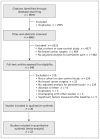Predictors of persistent pain after breast cancer surgery: a systematic review and meta-analysis of observational studies
- PMID: 27402075
- PMCID: PMC5047835
- DOI: 10.1503/cmaj.151276
Predictors of persistent pain after breast cancer surgery: a systematic review and meta-analysis of observational studies
Abstract
Background: Persistent pain after breast cancer surgery affects up to 60% of patients. Early identification of those at higher risk could help inform optimal management. We conducted a systematic review and meta-analysis of observational studies to explore factors associated with persistent pain among women who have undergone surgery for breast cancer.
Methods: We searched the MEDLINE, Embase, CINAHL and PsycINFO databases from inception to Mar. 12, 2015, to identify cohort or case-control studies that explored the association between risk factors and persistent pain (lasting ≥ 2 mo) after breast cancer surgery. We pooled estimates of association using random-effects models, when possible, for all independent variables reported by more than 1 study. We reported relative measures of association as pooled odds ratios (ORs) and absolute measures of association as the absolute risk increase.
Results: Thirty studies, involving a total of 19 813 patients, reported the association of 77 independent variables with persistent pain. High-quality evidence showed increased odds of persistent pain with younger age (OR for every 10-yr decrement 1.36, 95% confidence interval [CI] 1.24-1.48), radiotherapy (OR 1.35, 95% CI 1.16-1.57), axillary lymph node dissection (OR 2.41, 95% CI 1.73-3.35) and greater acute postoperative pain (OR for every 1 cm on a 10-cm visual analogue scale 1.16, 95% CI 1.03-1.30). Moderate-quality evidence suggested an association with the presence of preoperative pain (OR 1.29, 95% CI 1.01-1.64). Given the 30% risk of pain in the absence of risk factors, the absolute risk increase corresponding to these ORs ranged from 3% (acute postoperative pain) to 21% (axillary lymph node dissection). High-quality evidence showed no association with body mass index, type of breast surgery, chemotherapy or endocrine therapy.
Interpretation: Development of persistent pain after breast cancer surgery was associated with younger age, radiotherapy, axillary lymph node dissection, greater acute postoperative pain and preoperative pain. Axillary lymph node dissection provides the only high-yield target for a modifiable risk factor to prevent the development of persistent pain after breast cancer surgery.
© 2016 Canadian Medical Association or its licensors.
Figures



References
-
- Canadian cancer statistics 2014. Toronto: Canadian Cancer Society; 2014. Available: www.cancer.ca/~/media/cancer.ca/CW/cancer%20information/cancer%20101/Can... (accessed 2015 July 20).
-
- Breast cancer facts and figures 2013–2014. Atlanta: American Cancer Society; 2013. Available: www.cancer.org/acs/groups/content/@research/documents/document/acspc-042... (accessed 2015 July 20).
-
- Jung BF, Ahrendt GM, Oaklander AL, et al. Neuropathic pain following breast cancer surgery: proposed classification and research update. Pain 2003;104:1–13. - PubMed
-
- Kehlet H, Jensen Troels S, Woolf CJ. Persistent postsurgical pain: risk factors and prevention. Lancet 2006;367:1618–25. - PubMed
-
- Andersen KG, Kehlet H. Persistent pain after breast cancer treatment: a critical review of risk factors and strategies for prevention. J Pain 2011;12:725–46. - PubMed
Publication types
MeSH terms
LinkOut - more resources
Full Text Sources
Other Literature Sources
Medical
